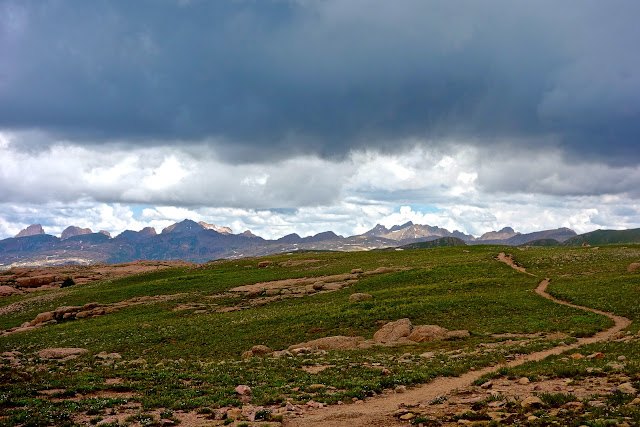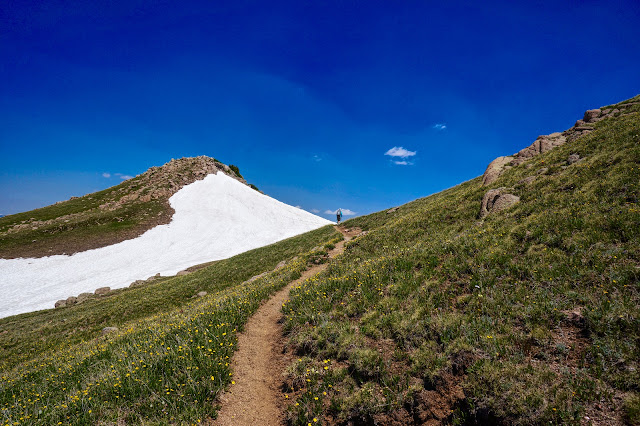Travel: From Durango, drive north on US Route 550 for 35 miles to Coal Bank Pass. Continue for one mile to mile marker 58. Park on the right side of the highway at a generous turn-out. Allow 45 minutes from Durango.
Distance and Elevation Gain: Coal Creek Trailhead to Pass Trailhead, 9.7 miles with 2,700 feet of climbing; 11.0 miles if you walk back to your vehicle on US 550.
Coal Creek Trailhead to Deer Creek Trailhead, 9.0 miles with 2,900 feet of vertical. Hitchhike back to your vehicle or add 1.4 miles and 600 feet of uphill on the highway.
Time: 5:00 to 6:00
Difficulty: Trail, off-trail; navigation moderate; One Class 3 pitch with mild exposure
Map: Engineer Mountain, Colorado 7.5' USGS Quad, or Apogee Mapping
Latest Date Hiked: July 11,2023
Quote: The simple things are also the most extraordinary things, and only the wise can see them. Paulo Coelho, The Alchemist
Jura Knob, left of center, appears after a mellow approach inspiring the thought, "Oh! I'm climbing a mountain after all."
Route: The black-line route is the standard loop hike to Jura Knob. Begin on the Coal Creek Trail, summit Jura Knob, and finish at the Pass Creek Trailhead. The hike works equally well in the opposite direction. Engineer Mountain is an optional side trip from this loop. The blue-line route descends from Jura Knob to the north, goes over Peak 12,594' (E3), Point 12,569' (E4), and stays on the ridge until it intersects the Deer Creek Trail. To climb Jura Knob from the Engineer Mountain Trail see the Molas Pass to Coal Bank Pass thru-hike. [2021 Note: the Pass Creek Trail is now called simply the Pass Trail.]
From mile marker 58, walk downhill on US 550 for 0.1 mile. Cross the road and find the lopsided sign for the Coal Creek Trail at 10,200 feet. The thin track scraped into a steep slope suspended above the two-lane rises steadily. Soon the path is swallowed by a subalpine fir forest and the road is forgotten. Loopy switchbacks are lined with limestone. Heavy timber gives way to sporadic trees at 11,200 feet, 2.2 miles. It is as smooth and easy as any 1,000 foot gain can be.
Engineer Mountain arises and remains a dominate presence for the duration. Columnar shafts snatch light. Luminescence shifts continuously, captivating the observer.
The Coal Creek Trail multi-threads and disappears overtaken by boisterous corn husk lily. If you lose the trail climb north for 0.15 mile and you will find it once again on an easterly ridge at the saddle west of Point 11,662'. Go west and reach the junction with the Deer Creek Trail at 2.6 miles. 2020 Note: The Coal Creek Trail is newly popular with mountain bikers and is impossible to miss.
If you are doing the blue-line route and wish to avoid the US 550 disconnect you may hike up the Deer Creek Trail to this location but it is steep, loose, and sun drenched. 2020 Note: These charming signs are now missing.
Continue west on the Coal Creek Trail for a few paces. Leave the trail and climb right/north up a short grassy pitch to meet the south ridge of Jura Knob at 12,000 feet. The ridge is a broad, wide-open expanse. Follow it to the false summit, shown. Walking is pleasant through a grassy landscape with almost no rock underfoot. (THW, photo)
Cross a band of whimsical white sandstone.
The summit structure presents as a cliff intruding through a red band. The crest is a relatively thin layer of grey rock. Local geologist John Bregar commented on Jura's rock formation. "The cliff band that is the crux of climbing Jura Knob is within the Cutler Formation. Though most of the Cutler consists of red alluvial sediment washed down from the Uncompahgre Mountains, there is much variability in that sediment--some layers are relatively find-grained and soft, other layers are coarse sand and gravel. Often the coarser sediments are more resistant to erosion and form cliffs while the softer sediments erode more easily to form the overlying and underlying slopes. There can even be an occasional limey bed within the Cutler, probably representing a temporary lake deposit. The summit of Jura Knob is made up of some of those limey deposits."
The ridge narrows just before the crux. Snow lingers late and accumulates early.
Upon reaching the red layer, stay on the ridgetop until you are forced to leave. Climb the remaining crumbly section on the right as shown. There is mild exposure here.
The crux is a single, seven foot hoist up the Class 3 "Corner Wall." It is located on the right/east side of the prominence. This is the easiest attack point. Some people may need a boost because, while handholds are good, footholds are stingy. The pitch is too much for dogs.
Next is a short and delightful block scramble and then a soft ridge walk to the summit at 4.2 miles. The crest is roomy and even though Jura is not the tallest mountain around, its singular location affords a sweeping vista of loftier peaks. Looking north, Vermilion Peak, 13,894', is just left of center in this image with Fuller Peak to its right. Rolling Mountain is image-left and the Twin Sisters are on the right. (THW, photo)
Jura Knob looks over the massive rock glacier on the north slopes of Engineer. The singular terrace of Grayrock Peak and Graysill Mountain is to my right. (THW, photo)
Black-line loop to the Pass Trailhead
Scramble down Corner Wall facing the rock. Shorter people may need a spot. Descend the south ridge as you came. Approaching the southern end, avoid any temptation to drop off to the right. Instead, as shown on the track above, make for the 12,000 foot knoll. There you will see the Deer Creek Trail 100 feet below at 5.8 miles. Go right/west and at 6.2 miles, come to a junction with the Engineer Mountain Trail. Turn left/south. Cross more green loveliness and enter a rich stand of conifers. The trail climbs lazily until it meets the Pass Trail at a 4-way junction at 7.2 miles, 11,720 feet.Here, our route turns left/east. However, if you are tempted to climb Engineer Mountain, 12,968', this is a fine opportunity. Simply turn right/west, shortly reach Social Rock, and carry on from there. This option will add 1.5 miles roundtrip and 1,250 feet of climbing.
The Bus Stop is a few paces down the Pass Trail and a favorite place for a break. From here, the trailhead is 2.4 miles down a well-engineered ultra popular trail for hikers and mountain bikers.
As you descend the trail, watch to your left for a final view of Jura Knob. The groomed dirt path is guarded by old and stately fir and spruce trees. At 8.3 miles, find a spur that hooks right and goes to a brook where queen's crown thrives. Pass a perfectly round pond at 8.6 miles. The pleasant grade is accomplished by sinuous switchbacks. Just before reaching the highway, in mid-summer the trail is engulfed by some of the best wildflowers in Colorado.
Reach the Pass Trailhead at 9.7 miles. If you must walk down the highway to the Coal Creek Trailhead, this will be the most dangerous segment of your hike so take care.
Blue-line route to the Deer Creek Trailhead
The terrain drops softly from Jura's summit on the north ridge; utilize a social trail through broken limestone. The Colorado Trail is quite close to the northwest. Pass east of two small ponds and simply follow the ridge as it swings east to ascend Peak 12,594' (E3). The saddle is at 12,220 feet making this ridge roller a legal summit. Climb the uniform gentle slope and crest at 5.4 miles. (THW, photo)
Be sure to look over the north side into a seldom visited basin south of the Lime Creek drainage. We saw (and heard) the largest herd of elk any of us had ever witnessed--200 strong at least.
The east side of Peak 12,594' has a cliff band equivalent geologically to Jura. However, the Class 2+ downclimb is without challenge. This image looks back at the scramble. The flower in the foreground is the uncommon Colorado tansy aster. We tracked four other somewhat rare flowers in this region: ivesia (mousetail), townsendia (Easter daisy), mountain dryad, and physaria (bladderpod).
The final prominence, Point 12,569' (E4), is easily gained. From there the ridge broadens as it moves south. To the east lies the Weminuche Wilderness cluttered with quirky and preposterous peaks in the Needle Mountains.
Look back on the Deer Creek basin and ridge. (THW, photo)
There is more than one route down to the Deer Creek Trail. We followed a southeast rib somewhat steeply through a healthy fir and spruce forest. The east-bearing trail is well-established and obvious. Just be sure to intersect the trail before it begins making switchbacks at 10,700 feet pointed south. Plunge through an aspen forest, the trees old and tall, vibrant green leaves fluttering.
If you are hitchhiking back to the Coal Creek Trailhead, walk up the highway to the next bend where there is a sizable pull-out to strengthen your chances of getting a ride.
Jura is commonly climbed in winter when it is indisputably more challenging. Approach the peak via either the Coal Creek Trail or Pass Trail. I prefer the latter because there is usually a beaten track up to Engineer Meadow. It is 11 miles out-and-back. We generally stash snowshoes at the crux. Corner Wall is dicier in the winter; it holds ice and snow. The exposure is amplified. The potential for avalanche exists at several places along the way. Figure 6 to 7 hours.




























































